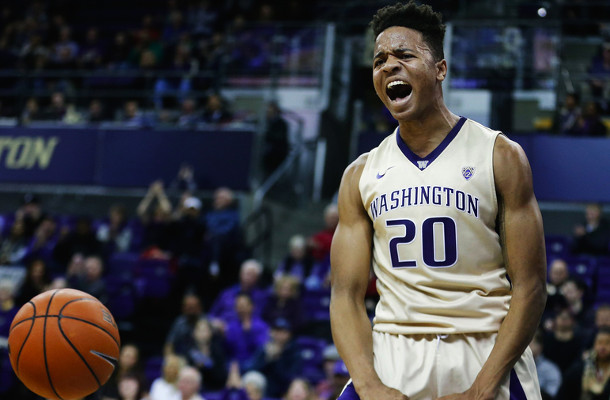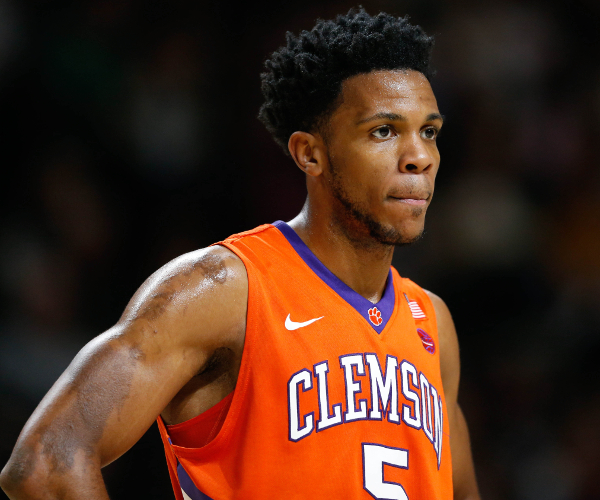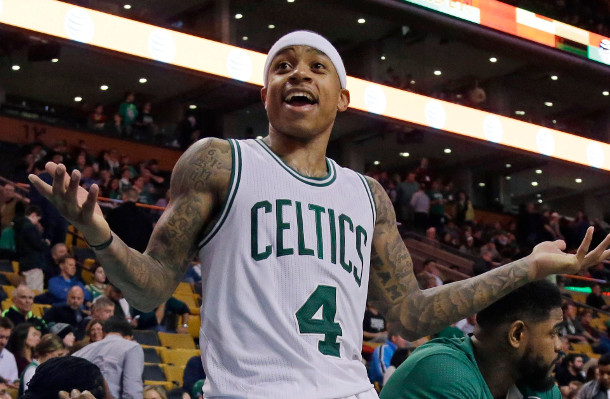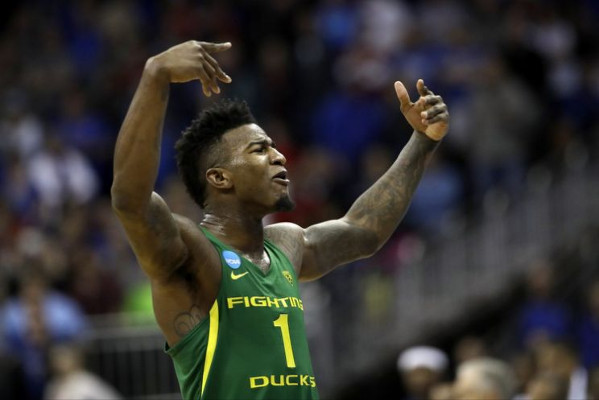Pick swaps, process trusting, and what the #3 pick means moving forward
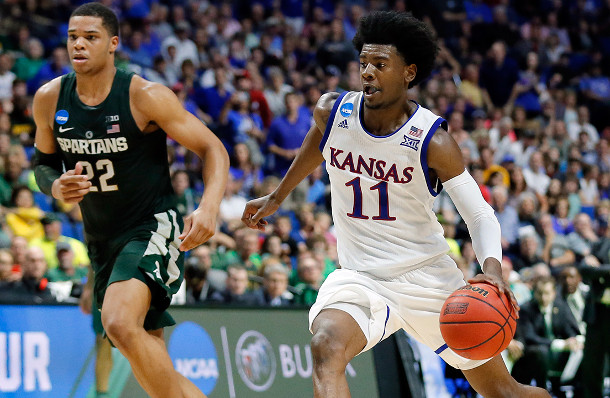
Former general manager Sam Hinkie’s controversial rebuilding plan has frequently been simplified down to “anybody can build a team to lose”, a reference to the team’s 47-199 record during Hinkie’s three-year tenure.
Yet lost in that oversimplification are various avenues the front office took to improve their odds in reaching their goals. Goals which were not, at the time, to win as many games as possible in the short term, but instead to acquire franchise level players. Moves that, even if they only improved the chances of success by a relatively minor amount, would add up to a significant improvement as a collective whole.
The results of last night’s NBA draft lottery, where the Sixers received the 3rd overall pick in June 22nd’s draft by virtue of a pick swap with the Sacramento Kings, is the perfect example of this approach.
When the Sixers made the trade with the Kings back in the summer of 2015 they received a, ahem, kings ransom, receiving Nik Stauskas, Carl Landry, Jason Thompson, the right to swap picks with the Kings (at the Sixers’ discretion) in the 2016 and 2017 drafts, and a future draft pick, in exchange for just the 47th pick (Arturas Gudaitis), 60th pick (Luka Mitrovic), and a little bit of salary cap flexibility.
The trade was, at the time, rightfully lauded as a coup for the Sixers, a massive haul for virtually no risk. Getting the rights to a draft pick, even a pick three-to-four years away, from a bad team, and for cap space the Sixers were likely never going to use was a great use of resources. The Kings eventually used that cap flexibility to acquire Rajon Rondo, Marco Belinelli, and Kosta Koufos. Even now, nearly two years later, it seems incredible they were so desperate to clear that room under the cap.
Related: read about Sachin Gupta, the architect of the Sixers/Kings trade
Yet even while the Sixers were rightfully regarded as the winners of that deal, most viewed the right to swap picks as a relatively meaningless component of the trade. The Kings, with franchise center DeMarcus Cousins in the fold, weren’t exactly known for a sustained run of playoff appearances. Or any playoff appearances in the last 11 years, for that matter. Still, they did just win 29 games, a number that looks small until you realize the Sixers won 11 fewer that season. Certainly the Kings finishing with a worse record than the Sixers in either 2015-16 or 2016-17 was unlikely to happen.
Through the 2016 draft that mindset looked to be correct, as the Sixers won just 10 games in 2015-16, landing the #1 overall pick that eventually became Ben Simmons. The Kings, on the other hand, wound up selecting 8th.
Yet what the Sixers did so well, knowing that guarantees were few and far between for a team in their position, was to play the margins. To improve their odds, even if ever-so-slightly, of getting elite talent.
Heading into last night’s NBA lottery the Sixers had an 8.6% chance of swapping picks with the Kings. A bump so small that many people would chalk it away as insignificant, but a number big enough to draw the attention of those looking to find any edge they can to accomplish the goal of acquiring elite talent. It is simultaneously the most important, and the most difficult, task a franchise has to accomplish.
That 8.6% chance ended up being significant, as it caused the Sixers to jump from 5th in the draft to 3rd after the swap was exercised. And while the difference between selecting 3rd and 5th might seem small, it’s not.
The top pick in the draft is generally a slam dunk, where consensus does a relatively good job of weeding out the most talented prospect available. Start moving down even a few spots and that success rate drops precipitously, and a GM’s ability to find the flaws that can be overcome, the strengths that will translate, and the areas that can be improved upon are paramount to success.
It seems simple, but it needs to be stated: in this world of high stakes draft picks, having more options to select from a huge benefit. The difference between Joel Embiid and Dante Exum. Between Otto Porter and Alex Len. Bradley Beal instead of Thomas Robinson. Even if you correctly scout Kristaps Porzingis and pick him out as a future superstar, a task that looks easy only now in hindsight, that work is wasted if you’re selecting 5th in his draft.
If you were sitting in a coffee shop in Palo Alto right now you’d likely find Sam Hinkie mumbling under his breath that the results of the lottery don’t make the Kings trade any smarter. He’d be right. But it’s still undeniable that the actions they took to move the odds in their favor will be more readily acknowledged now that those transactions led to the 3rd pick in the draft rather than just some vague percent increase in odds that bore no fruit. It’s human nature.
The need for elite talent to compete in the NBA is anything but a new revelation, and it doesn’t take a rocket scientist to figure out that the best way to get them is at the top of the draft. What the Sixers did more effectively than most others taking this path is in their pursuit of the margins.
In realizing where they were in their rebuild, in using their cap space to increase their lottery odds rather than short-term gains on the court, in an honest appraisal of players like Michael Carter-Williams, and in a reluctance to assume one year in the lottery was enough to guarantee a core capable of growing into a contender, a realization that even the Golden State Warriors can Festus Ezeli their way into a wasted draft pick. None of them were moves which provided guarantees, but instead moved the needle ever-so-slightly and turned a low percentage play into something a little bit more palatable, and with the upside to make it worth the gamble.
They created their own luck.
Options are good. Options can be the difference between success and failure. And thanks to the foresight of those no longer here, the Sixers now have more options than they otherwise would have had. The margins have been effectively played.
Bryan Colangelo’s awkward position
It is fitting that the benefits of the previous regime’s obsessive pursuit of marginally better odds resulted in a tangible, and significant, gain for the organization on a night when fans jammed into XFINITY Live for the Rights to Ricky Sanchez lottery party, where they raised a banner of Sam Hinkie to the rafters and cheered their way through a jubilant celebration with 3,000 of their closest friends.
This offseason has been presented by many, including RTRS themselves, as the end of The Process. In many ways that’s true. The architect, Hinkie, is now a full year removed from being with the team. The stated goals of the organization now drastically different than they were when Hinkie was hired, and even when he left. Whether that change in organizational direction is driven by the change in management or the presence of foundational pieces in Embiid and Simmons, or some combination of the two (likely), is almost beside the point. The philosophy will change.
Yet because of the long view Hinkie and his team took, the benefits are set to keep rolling in, with an unprotected pick in the 2018 draft coming from the Lakers and one in 2019 from the Kings, two of the league’s more consistently dysfunctional franchises. It’s an almost embarrassing amount of riches for a team that could be climbing up the standings on the backs of talents like Embiid and Simmons, leading some to dub the Sixers the next Boston Celtics. It’s a fact that led majority owner Joshua Harris to make an awkward comment thanking the man he had just demoted a year ago.
That does place Colangelo in a little bit of an awkward spot. If he hits on another star with the 3rd pick in June 22nd’s draft, the opportunity to do so was given to him by the meticulous planning of Hinkie and his team. If he misses on the pick he’s squandered the perfect opportunity. If he trades the pick and it works, it’s an opportunity that may not piqued the other team’s interest if the Sixers had the 5th pick instead. If the trade doesn’t pan out, he’s the short-sighted executive who tried to rush The Process.
That’s going to be true of virtually any move Colangelo can make. Even if Colangelo makes the right moves, Hinkie’s fingerprints will follow the team for the foreseeable future, thanks to the plethora of young talent on the roster and the future assets yet to come which have positioned the team so well. The court of public option is a seemingly no-win battle for Colangelo, and it has very little to do with Colangelo himself.
Impact of selecting third
It’s not just the fact that the Sixers are now slotted with the 3rd overall pick which makes this situation interesting, but which teams landed the top-2 picks as well.
What the Celtics do with their pick is going to generate a lot of attention over the next month, and rightfully so. The Celtics can go down two very distinct paths, both of which seem legitimate for a team that just won 53 games without what most would deem a true, two-way franchise player: use the rare opportunity for a good team to extend their window of being relevant by drafting a franchise cornerstone, or use the value of the #1 pick to trade for a current star who might be on the market, and who might help this very good Celtics team take the next step.
If they keep their pick, some will speculate that they could go with a forward, such as Josh Jackson or Jayson Tatum, because of their guard depth. This seems like wishful thinking to me, as the Celtics also have Jaylen Brown (3rd overall pick in 2016) and Jae Crowder (26-years-old and on a cheap, long-term contract) as key pieces. It makes sense for the Celtics to take the player they think has the best chance of being special, and most believe that to be Markelle Fultz.
If the Celtics do decide to move the pick, it seems far more likely they would do so in order to get a current star to help them legitimately compete for a title, not trade down and get more young assets. Either way, it seems likely Fultz will go #1 overall, even if the team that ultimately selects him might be somewhat up in the air.
With the continued rumors of the Lakers’ infatuation with Lonzo Ball that leaves the Sixers in a tough predicament. Most would regard Kansas freshman Josh Jackson as the best remaining talent, but there are significant concerns around the league over his perimeter shooting, and the Sixers already have considerable depth at the forward spots with Robert Covington, Ben Simmons, and Dario Saric.
That opens up a lot of possibilities. Could the Sixers target a better fit, like Malik Monk, even if most don’t consider him in the conversation for the 3rd best prospect? Could they look to trade down, say to a team like the Kings, who now own the 5th pick, to get the guy they’re targeting while adding in more assets along the way? Or could the Sixers, now that their pick has more league-wide value, look to move the pick in a package to acquire an established star, and push them further down the road to contention?
Jackson feels like the favorite, but the events of last night opened up quite a few possibilities that will be discussed over the next month.
If the Sixers go Jackson…
If the Sixers do go with Josh Jackson with the third overall pick, that opens up a couple of interesting possible side stories.
The first thing that jumps to mind is whether drafting a wing like Jackson, rather than a guard like Fultz or Ball, would make it more likely that the Sixers pursue the oft-rumored Kyle Lowry in free agency.
I wrote about the pursuit of Lowry last week (subscribers), and there’s a lot to unpack when figuring out whether signing him in free agency makes sense for where the 76ers are at. One of the considerations was whether the addition of Lowry, alongside Ben Simmons and a recently drafted point guard, would take the ball out of each of their hands enough to limit them from reaching their peak potential, and limit them from becoming what makes them worth the considerable investment it would take the acquire them.
If the Sixers select Jackson with their now-lone first round pick, that concern is not as prevalent. It’s a lot easier to envision the touches being there to accommodate Lowry, Simmons, and Jackson than it would have been for Lowry, Simmons, and Fultz.
The second potential side effect would be the impact on the current forwards on the roster, specifically Dario Saric and Robert Covington.
The selection of Jackson may not impact Saric all that much, especially since I think there’s a real case to be made that Saric’s best role is as a backup power forward anyway. Yet it may impact the amount of time Simmons would play the small forward spot, which would have a trickle down effect on Saric’s playing time and role. It’s not enough to think a move is imminent in any regard, but it might be something to look out for.
Covington is a little bit trickier. On the one hand, I don’t think selecting Jackson would mean Covington is on the block. On the other hand, would it impact the status of Covington’s extension/renegotiation?
It’s possible a Covington/Jackson/Simmons wing/forward trio might work on both sides of the court, and it’s also certainly feasible that if it doesn’t Covington could slide to the bench and still get significant minutes, where he’d continue to be valuable because of his perimeter shooting and defensive versatility. But the team may want to wait to see exactly how big Covington’s future role will be before committing major money to him, which might hold up the interest in an extension until more information is gathered. Again, it’s nothing absolute, but it might be something to watch.
Finally, there’s the consideration over whether falling in at third might make the Sixers *more* likely to trade their pick for an established player. The thought here is that the pick is likely more valuable league-wide now that it’s slotted in as the 3rd pick and could be reasonably translated into Josh Jackson than it was 24 hours ago. But, because of Jackson’s shooting concerns and how that impacts his fit with Embiid and Simmons, the value of the pick may not have increased as much in the Sixers’ eyes as it did elsewhere. If there was any interest in pursuing a star-level player the likelihood of a common ground being found may have become more likely as a result of last night’s lottery.
“We’re going to look at all options. All means of improving this team. We’ll look at both a quicker pace and a more measured pace, it just really depends on what unfolds in the process of the next few weeks,” Sixers president of basketball operations Bryan Colangelo told members of the media today. “I’m not saying I will (trade the pick). What we say all the time is we leave all of our options open and we’ll look at all the scenarios that could play out with respect to the value of that draft asset.”
Where the draft pick ended up falling, and the top guards in the draft potentially being out of play, may not make this appreciably more likely, but it is within the realm of possibilities.
Impact on Celtics/Lakers rosters
Fultz and Ball are widely expected to be selected by the Celtics and Lakers, respectively. Or at least the team selecting #1 in the draft is expected to take Fultz.
The attention with the Celtics naturally shifts to whether they’d consider trading the #1 overall pick, and they are certainly likely to at least explore that possibility. But as I said above, I don’t think the Celtics are going to pursue *more* youth and draft picks for the right to draft Fultz. I think there’s a disconnect between how frequently people talk about going with the best player available and this being a superstar’s league then, once they’re slotted in lower in the draft they’re able to convince themselves that the teams at the top would be best served to trade out of that enviable position. I don’t think the desire is there nearly as much as we hope it is.
For the Lakers, the future of D’Angelo Russell has already come under question. The disappointing second-year guard seems to overlap, at least initially, with the sweet passing Lonzo Ball. Still, there’s enough shooting and passing between the two that I would be surprised if the Lakers traded Russell at the nadir of his value.
Instead, it might be guys like Marcus Smart, Jordan Clarkson, or even Avery Bradley who become available, at various cost (Bradley’s obviously way, way higher). Is there interest in any of those? Clearly there would be for Bradley, but I think that’s the level of fallout we’d be talking about, not Fultz or Russell becoming available to a team like the Sixers.
There are a lot of different ways the Sixers can go with this pick, both in terms of who they select, the fallout from other teams, how it impacts free agency, and what trades they pursue. That should make for an interesting few weeks.
Related Posts
-
omachoomar
-
Derek Bodner
-
-
Brett77
-
Derek Bodner
-
Kevin Herman
-
-


